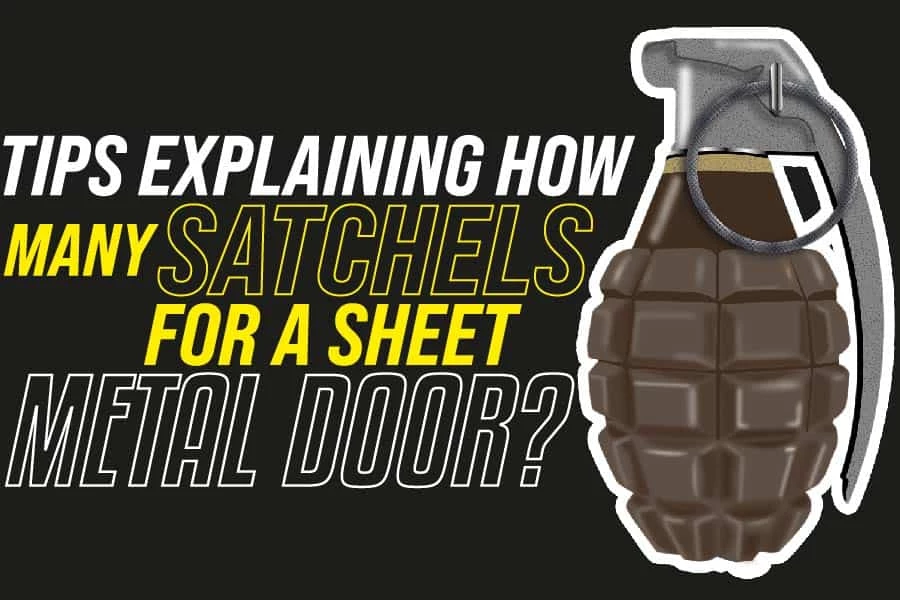Do you know how many satchels for a sheet metal door is enough? If not, then you shouldn’t skip this post.
A satchel is a compact explosive device made of beancan grenades. It is useful in demolishing wood and sheet metal doors. You’d probably have no reason to use a satchel or satchel charge unless you want to blow up a building door or some barrier.
Well, that’s what happens in Rust, a thrilling multiplayer game where survival depends on how you can gather items, most of which you’d have to steal by conducting raids.
One of the barriers you’ll likely face is a sheet metal door. So naturally, you’ll need a satchel charge to blow it up. Now, the question is how many.
How Many Satchels For A Sheet Metal Door?
To destroy a sheet metal door or a sheet metal double door, you’ll need four satchel charges. Like the double sheet metal door and ladder hatch, Sheet metal doors have the same hit points and defensive bonuses.
Sheet metal doors have 250 hit points and 150 metal fragments. They are fireproof and resistant to hatchets but weaker than other goods and building sections for big impacts like explosives, boulders, maces, and clubs.
Tip: Another alternative is to find a weaker entry point into a sheet metal door, such as breaking the wooden doorframe. If the door isn’t locked, you can use the use button to open it and take it up.
The Satchel Charge
The satchel charge is an explosive device for raiding player houses. Once placed at a location, the satchel charge becomes active and detonates after a while.
The satchel charge is not a reliable tool. It can malfunction at any time, requiring the player to rearm it again. Sometimes in picking it up to rearm, a satchel charge can reignite and explode and after a short while.
When hurled, satchel charges may “dud.” Instead of exploding, such satchels need interaction from the user. The satchel either returns to the player’s inventory or re-ignites with a shorter fuse when this occurs.
Remember that crafting is part of the game, and a player can make or build several items, including a satchel charge. Do you want to know how to make a satchel charge? Continue reading.
How To Make A Satchel Charge
You’ll find satchel charges in the crafting menu under the tools category. Crafting a satchel charge will require the following materials:
- A rope
- A small stash
- Four Beancan Grenades
With these materials, you can craft a satchel charge within 30 seconds. However, you can still make a satchel charge from scratch if you don’t have these materials; only you’ll take a longer time.
So, to craft a satchel charge from scratch, you’ll need some raw materials to make beancan grenades. If you have Sulfur, you’ll need 480 to make gunpowder for your beancan grenade. However, in the absence of Sulfur, you can still make gunpowder with 720 Charcoal.
Also, eighty pieces of metal fragments will be enough to make a beancan grenade. Finally, you can make a stash from ten pieces of cloth. Add a rope and your toolbox is complete with crafting one satchel charge.
The Beancan Grenade
The Beancan Grenade is a handmade explosive in Experimental Rust. You can throw the beancan grenade using the primary firing button or the left mouse button.
Although effective, the beancan grenade can sometimes be unreliable due to its improvised nature. For example, the grenade may or may not go off, or it may go off after a long or short delay.
It can cause significant damage up close, and it almost always gives the Bleeding effect to the player. However, it has a long, simple wick that lets it be thrown without killing both the target and the player throwing it.
The player can also pick up an unlit or lighted bean can grenade from the ground and throw it as needed. However, this may not be the option in conflict because a lit grenade can explode late, hurting or killing the person picking it up.
Occasionally, the grenade will be a dud and unusable. The beancan grenade is a one-time use item unless it’s a dud. When a dud is picked up, it has a 50% chance of reigniting.
Instead of throwing the beancan grenade, you can drop it with the right mouse button. Also, right-clicking on a structure or door will stick it to that structure or door instead of just tossing it against the door; this makes it slightly more effective.
Because of its unpredictable detonation and a 15% chance of completely fizzing, the beancan grenade is extremely unstable. With a 50% probability of exploding when picked up after fizzling, the beancan grenade is often as deadly for the user as it is for the target.
A beancan grenade can be used as a raiding tool to supplement other raiding tools. For example, you can save a Rocket or explosive ammunition by utilizing extra beancan grenades to destroy a wall or door when only a little amount of damage is required.
Beancan grenades are a key component of raiding tools like the Satchel Charge.
However, if you must use the beancan grenade, you can throw one or stick it to a nearby surface by pressing the Left-Click button on your mouse. Unfortunately, Beancan grenades can’t be made using empty bean cans, which is a bit of a bummer.
About The Rust Game
Rust is a multiplayer survival video game created by Facepunch Studios. Although the game first became available in December 2013 as early access, the creators released the full version nearly five years later in February 2018.
The game is available on macOS and Windows. And as recently as May this year, it became available on PlayStation and Xbox One.
Rust is all about survival in a wilderness filled with hostile animals. And to boost survival chances, players must gather or even steal resources. In addition, players must endure difficult circumstances, including thirst, hunger, and life-threatening situations.
Although they’re dangerous, wild animals are not the greatest threat to players. The game is multiplayer-only, so the biggest threat comes from other players.
Every player has access to various weapons and firearms to aid combat. Players also have access to vehicles they can use in roaming and attacking other players.
Crafting is also part of the game, although you can’t enjoy this feature until you’ve discovered specific items during gameplay. Players can protect themselves by joining clans or building bases because they’re always in danger of raiding.
Rust Gameplay
Rust pits players against one other in a cruel open world with only one goal: survival. Although wolves and bears pose a menace, the other players pose the greatest danger. Most maps are generated procedurally, except for a few pre-built levels. In the beginning, a player has a rock and a torch.
The rock can chop trees, smash rocks, and act as a weapon. Players can make fabric and food by decomposing animals. Stone and sulfur ore are mining products, and lumber comes from cutting down trees. You’ll need to collect materials to make tools, weapons, and other stuff to survive.
Advanced products demand increasingly exotic components spread across the landscape. As a result, this necessitates the acquisition of all necessary materials. As a result, there’s a restriction on the number of craftable items. However, blueprints enable the creation of more complex products.
Other Barriers That Need Satchel Charge
Two satchel charges will blow up a sheet metal door. But a sheet metal door isn’t the only barrier you’d face in Rust. There are many others. So let’s go over some of them and see how many satchel charges they require.
Wooden building tier:
To demolish any item in the wooden building tier, you’ll need three satchel charges. These items include foundations, walls, floors, door frames, wall frames, staircases, roofs, windows, and floor frames, except the wooden door.
To smash the wooden and double doors, you’ll need two satchel charges.
The reason you require two satchel charges is this. Wooden doors in Rust boast 200 HP, so they’re not that resistant to damage. Keep in mind that a single satchel charge will remove 150 HP from the wooden door. Thus, you’ll require two satchel charges to take the door down.
Now the question is this. Are two satchel charges necessary to take down wooden doors? The answer is no! You don’t need to waste two satchel charges on a wooden door.
Since one satchel charge can take away 150 HP from the wooden door (wooden doors have 200 HP), you’ll have 50 HP left. Instead of wasting a satchel on the remaining 50 HP, you can simply use a different weapon to bring the door down.
You can shoot the door with some incendiary rounds and watch the door disappear in a few seconds.
A Handy Tip: The side of the door you deployed your satchel doesn’t matter. The door will still suffer the same amount of damage.
Stone building tier:
To demolish any item in the stone building tier, you’ll need ten satchel charges. These items include foundations, walls, floors, door frames, wall frames, staircases, roofs, windows, and floor frames.
Components and refined materials
- 10 Ropes
- 10 Satchels
- 2400 Gunpowder
- 40 Beancan Grenades
Metal building tier:
To demolish any item in the metal building tier, you’ll need three satchel charges. These items include foundations, walls, floors, door frames, wall frames, staircases, roves, windows, and floor frames, except the sheet metal door.
Components and refined materials
- 4 Satchels
- 4 Ropes
- 16 Beancan grenade
- 960 Gun Powder
Armored building tier:
To demolish any item in the armored building tier, you’ll need three satchel charges. These items include foundations, walls, floors, door frames, wall frames, staircases, roves, windows, and floor frames, except the armored door. To demolish the armored door or the armored double door, you’ll need 12 satchel charges.
Others include a latch door, prison cell wall, garage door, and metal shop front. To demolish the ladder hatch and prison cell wall, you’ll need four satchel charges. The garage door requires nine satchel charges, while the metal shop front requires 18.
Components and refined materials
- 12 Ropes
- 12 Satchels
- 48 Beancan Grenades
- 2880 Gun Powder
How Many Satchels For Garage Door Is Enough?
The first thing to consider is how many HP the garage door has. With that, you can determine the amount of satchels to use.
In Rust, garage doors have 600 HP, making them more resistant to damage or the impact of satchels. A satchel will remove only 61 HP from a garage door. Therefore, you’ll need around 10 satchels to bring down or damage a garage door.
Note that 9 satchels will remove 549 HP from the garage door, meaning you’ll have 51 HP left, to destroy. Now, it’s up to you to decide whether to risk using a satchel on the 51 HP left or using other means to finally damage the garage door.
A Handy Tip: Using 9 or even 10 satchels on a single door is actually a lot. So it would be best to use non-armored and normal doors.
Conclusion
So, how many satchels for a sheet metal door is enough to damage it? A satchel is a beancan grenade-based small explosive weapon. You can use it to demolish wood and sheet metal doors in the Rust Game to raid a player’s house. Four satchel charges are required to demolish a sheet metal door.
In Rust, players must gather or even steal resources to improve their chances of survival. Players must also deal with various challenges, such as thirst, hunger, and life-threatening events.
You can create satchel charges with a few items, the most essential of which are beancan grenades, as part of the game’s crafting system.
 Being Human
Being Human




